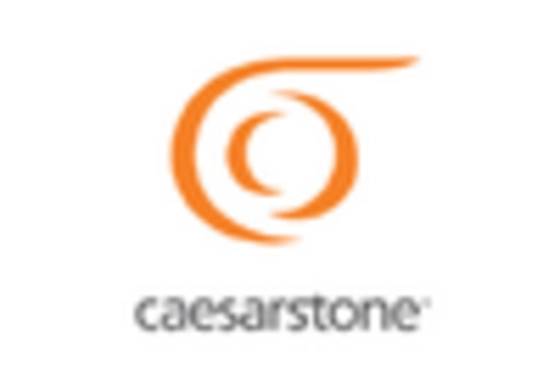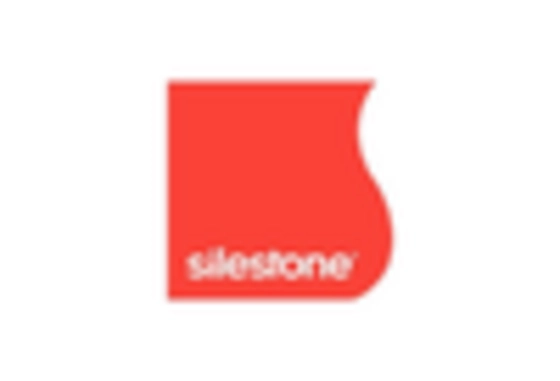The Engineered Stone Market is currently characterized by a dynamic competitive landscape, driven by innovation, sustainability, and strategic partnerships. Key players such as Caesarstone (IL), Silestone (ES), and Cambria (US) are actively shaping the market through their distinct operational focuses. Caesarstone (IL) emphasizes product innovation, particularly in developing eco-friendly surfaces, which aligns with the growing consumer demand for sustainable materials. Silestone (ES), on the other hand, has positioned itself as a leader in design aesthetics, leveraging its extensive color palette and textures to appeal to high-end residential and commercial markets. Cambria (US) focuses on regional expansion, particularly in North America, enhancing its distribution channels to capture a larger market share. Collectively, these strategies contribute to a competitive environment that is increasingly focused on differentiation through quality and sustainability rather than mere price competition.
The Engineered Stone Market exhibits a moderately fragmented structure, with several key players vying for market share. Companies are adopting various business tactics, such as localizing manufacturing to reduce costs and optimize supply chains. This approach not only enhances operational efficiency but also allows companies to respond more swiftly to regional market demands. The collective influence of these key players fosters a competitive atmosphere where innovation and customer-centric strategies are paramount, further intensifying the rivalry among them.
In August 2025, Caesarstone (IL) announced the launch of its new line of sustainable engineered stone products, which utilize recycled materials and eco-friendly manufacturing processes. This strategic move not only reinforces Caesarstone's commitment to sustainability but also positions the company favorably in a market increasingly driven by environmental considerations. By prioritizing eco-conscious products, Caesarstone (IL) aims to attract a growing segment of environmentally aware consumers, thereby enhancing its competitive edge.
In September 2025, Silestone (ES) unveiled a partnership with a leading design firm to create a series of exclusive countertop designs. This collaboration is significant as it allows Silestone (ES) to tap into the design community, fostering innovation and expanding its reach within the luxury market segment. By aligning with influential designers, Silestone (ES) enhances its brand visibility and positions itself as a trendsetter in engineered stone aesthetics, which could lead to increased market share.
In October 2025, Cambria (US) expanded its distribution network by entering into a strategic alliance with a prominent home improvement retailer. This move is crucial as it not only broadens Cambria's market access but also enhances its visibility among consumers seeking premium engineered stone products. By leveraging the retailer's established customer base, Cambria (US) is likely to see a significant uptick in sales, further solidifying its position in the North American market.
As of October 2025, the Engineered Stone Market is witnessing trends that emphasize digitalization, sustainability, and the integration of advanced technologies such as AI in manufacturing processes. Strategic alliances are increasingly shaping the competitive landscape, enabling companies to pool resources and expertise to drive innovation. Looking ahead, it appears that competitive differentiation will evolve, with a pronounced shift from price-based competition to a focus on innovation, technology, and supply chain reliability. This transition suggests that companies that prioritize these elements will likely emerge as leaders in the Engineered Stone Market.

















Leave a Comment